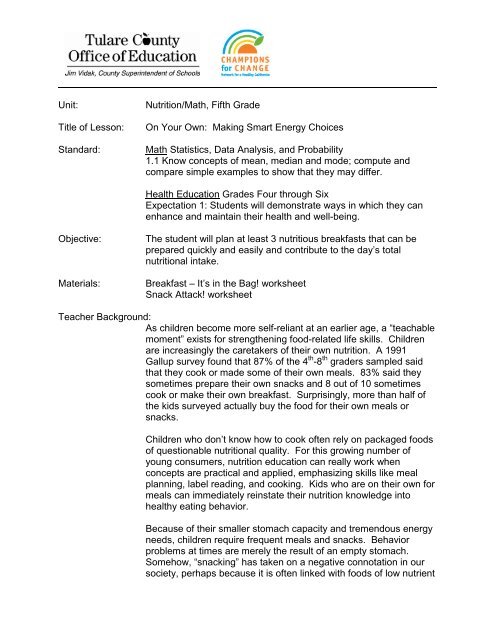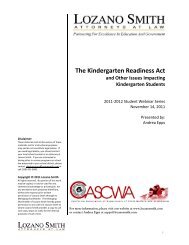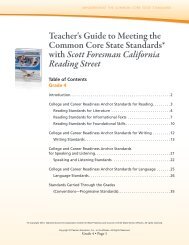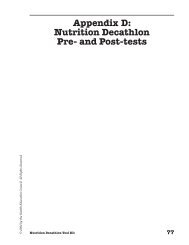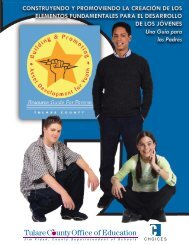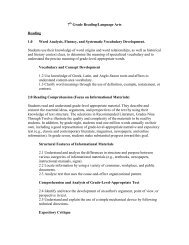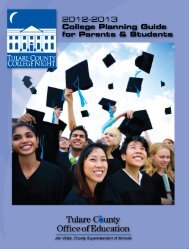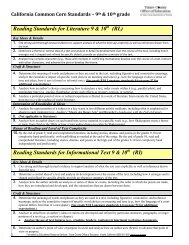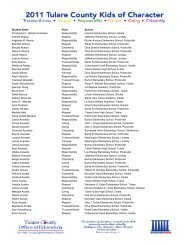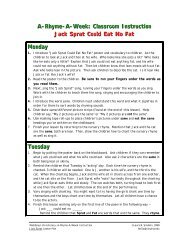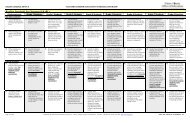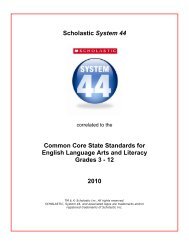Unit: Nutrition/Math, Fifth Grade Title of Lesson: On Your Own ...
Unit: Nutrition/Math, Fifth Grade Title of Lesson: On Your Own ...
Unit: Nutrition/Math, Fifth Grade Title of Lesson: On Your Own ...
You also want an ePaper? Increase the reach of your titles
YUMPU automatically turns print PDFs into web optimized ePapers that Google loves.
<strong>Unit</strong>:<strong>Title</strong> <strong>of</strong> <strong>Lesson</strong>:Standard:<strong>Nutrition</strong>/<strong>Math</strong>, <strong>Fifth</strong> <strong>Grade</strong><strong>On</strong> <strong>Your</strong> <strong>Own</strong>: Making Smart Energy Choices<strong>Math</strong> Statistics, Data Analysis, and Probability1.1 Know concepts <strong>of</strong> mean, median and mode; compute andcompare simple examples to show that they may differ.Health Education <strong>Grade</strong>s Four through SixExpectation 1: Students will demonstrate ways in which they canenhance and maintain their health and well-being.Objective:Materials:The student will plan at least 3 nutritious breakfasts that can beprepared quickly and easily and contribute to the day’s totalnutritional intake.Breakfast – It’s in the Bag! worksheetSnack Attack! worksheetTeacher Background:As children become more self-reliant at an earlier age, a “teachablemoment” exists for strengthening food-related life skills. Childrenare increasingly the caretakers <strong>of</strong> their own nutrition. A 1991Gallup survey found that 87% <strong>of</strong> the 4 th -8 th graders sampled saidthat they cook or made some <strong>of</strong> their own meals. 83% said theysometimes prepare their own snacks and 8 out <strong>of</strong> 10 sometimescook or make their own breakfast. Surprisingly, more than half <strong>of</strong>the kids surveyed actually buy the food for their own meals orsnacks.Children who don’t know how to cook <strong>of</strong>ten rely on packaged foods<strong>of</strong> questionable nutritional quality. For this growing number <strong>of</strong>young consumers, nutrition education can really work whenconcepts are practical and applied, emphasizing skills like mealplanning, label reading, and cooking. Kids who are on their own formeals can immediately reinstate their nutrition knowledge intohealthy eating behavior.Because <strong>of</strong> their smaller stomach capacity and tremendous energyneeds, children require frequent meals and snacks. Behaviorproblems at times are merely the result <strong>of</strong> an empty stomach.Somehow, “snacking” has taken on a negative connotation in oursociety, perhaps because it is <strong>of</strong>ten linked with foods <strong>of</strong> low nutrient
density. Chosen properly, snacks can and do make a bigcontribution to daily nutrition. Healthful snacks should mirror meals– emphasizing healthful foods, but in smaller quantities.Breakfast is the meal most directly connected to schoolachievement. Children who skip breakfast have shorter attentionspans; do poorly in tasks requiring concentration, and even scorelower on standard achievement tests. When researcherscompared the diets <strong>of</strong> children who qualify for breakfast with thosewho don’t, they found that the breakfast skippers never fullycompensate for the missed meal throughout the day. Children whoate a morning meal took in far more nutrients over the course <strong>of</strong> theday than those who missed breakfast.When children eat several meals each week at fast foodrestaurants, it is very likely that they will consume an excessamount <strong>of</strong> fat and calories. Students can more easily balance theirdaily food choices if they become informed about the nutrientcontent in fast foods and learn to plan their meals accordingly.Procedures:Introduction: Part A (30 minutes)Take an informal poll, asking students how many <strong>of</strong> thema. eat breakfast most daysb. prepare their own breakfast most daysc. prepare their own snacks most daysd. decide what they will eat when dining at a restaurantTally the results on the board or overhead. What is the mean(average)? What is the median (which number falls in the middle)?What is the mode (the number in a given set <strong>of</strong> numbers thatappears most frequently)?Explain/discuss the importance <strong>of</strong> learning to make independentand informed choices about food and eating.Explain the importance <strong>of</strong> the breakfast meal, describing how itliterally “breaks the fast”, providing fuel for both body and brain.Ask students to calculate how many hours normally elapsebetween the evening meal or evening snack and breakfast. Pointout that breakfast has been proven to affect how well studentsperform academically, especially during the morning hours.Activity:
Distribute Breakfast–it’s in the Bag worksheets. Explain theimportance <strong>of</strong> making a plan for breakfast. Allow students tocomplete the worksheet either in small groups or independently.Facilitate sharing <strong>of</strong> responses.Mystery Activity: Students are asked to write down three <strong>of</strong> theirfavorite ingredients at the bottom <strong>of</strong> this worksheet. In pairs orsmall groups, have students share their three ingredients. Assignthem to combine these foods to create a meal. For example, if thestudents wrote eggs, bananas, peanut butter, celery, ice cream andcereal; their menu might be a banana and celery omelet with apeanut butter and cereal ice cream sundae. The object is to becreative and have fun.Introduction: Part B 30 minutesAsk the students what the word snack means to them. Write theirresponses on the board or overhead. Ask how many thinksnacking is a good habit or a bad habit. Explain/discuss thatsnacking is an important way to keep the body fueled throughoutthe day. Encourage students to think <strong>of</strong> snacks as mini-meals andto choose foods from the food groups.Activity:Distribute the Snack Attack worksheets. Explain the importance <strong>of</strong>making a plan for snack-time. Allow students to complete theworksheet, either in small groups or independently. Facilitate thesharing <strong>of</strong> responses.Extension Activity:Act it Out: Pretend you are encouraging a young child to eatbreakfast and she/he is resisting. What would you say to him/her toconvince him/her breakfast is important?Create a dialogue:Pretend you are a body talking. You’ve just received a low nutrientdensemeal (lots <strong>of</strong> foods found at the “tip” <strong>of</strong> the pyramid, or thatfall into the fats and sweets category), adequate in energy butinsufficient vitamins and minerals. Describe how you feel.Assessment:Assess the students’ ability to plan nutritious breakfasts that can beprepared quickly and easily and contribute to the day’s totalnutritional intake. Assess the students’ ability to compute mean,median and mode.


